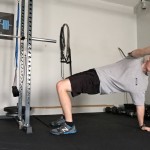Mobility is a term being thrown around in a lot in gyms today. You may have heard someone mention it, but do you know what it means? Renowned physical therapist Gray Cook would say its your freedom of movement at each joint. He created the Functional Movement Screen (FMS), which serves as an assessment for joint mobility and stability.
One of the big test within this system is the Active Straight Leg Raise. This test challenges your ability to obtain separation through your hips. It looks like this.
To perform this test you have to keep one hip in extension, while simultaneously bringing the other hip into flexion. This is very challenging for a lot of people. If someone is not able to do this there may be several issues at play here such as pelvic position and lack of trunk/pelvic stability.
The FMS is comprised of seven different tests. By performing all of them, it may provide a clearer picture as to why someone cannot do this. For the purpose of this post I am not concerned about that. I want to provide you with some reasons why this may happen and how to fix it.
When person cannot perform and Active Straight Leg Raise appropriately, they have lost the ability to separate their hips. If they are not able to do this it could cause some problems, including back pain or knee pain . Although pain is not always the result of mobility problems.
If you have ever heard of the joint-by-joint approach then you may know why. If you haven’t, then get ready because this will change the entire way you train. This concept was created by Gray Cook and Mike Boyle, a strength and conditioning coach in Massachusetts.
It pretty simple: Each joint is primarily a mobile joint (able to perform a certain movement) or a stable joint (able to resist a certain movement) (1). So think about it this way. The ankle should have a large range of movement in all three planes of motion.
The knee on the other hand primarily moves through one plane of motion.

Photo Credit: http://quizlet.com/6083574/kinesiology-knee-joint-soft-tissue-pathologies-special-tests-flash-cards/
This occurs up the entire body. Here is a list of the joints.
1) Ankle- Mobile
2) Knee- Stable
3) Hip- Mobile
4) Lumbar Spine- Stable
5) Thoracic Spine- Mobile
6) Scapula (shoulder blade)- Stable
7) Glenohumeral (shoulder)- Mobile
Based on this line of thinking, each joint has a distinct function. If one joint is not performing it’s job, you will compensate at another joint so you can perform that job. Example: If you lack hip mobility, your lumbar spine or knee could begin to become more mobile so you can still perform a specific movement. Let’s use walking as our movement example. If you are unable to obtain hip extension, which you need to push you forward with each step, you could potentially hyperextend the lumbar spine or the knee to compensate.
Notice how this person substitutes lumbar hyperextension for hip extension. The low back is severely arched as a way to extend the hip without using the hip.
Also, notice how this person substitutes knee hyperextension for hip extension on the right leg in the picture A.

Photo Credit: http://www.kneeguru.co.uk/KNEEnotes/courses/ posterolateral-corner-injuries-knee-course-frank-noyes-md/key-structures-posterolateral
Now, these people in the pictures may not lack hip mobility. However, compensations like these could eventually lead to pain or injury down the road if it isn’t corrected. So, you may be asking how do I correct it? Well I’m glad you asked!
You have to restore your hip mobility. One of the best exercise I have seen do this is leg lowering. This allows you to get separation through the hips passively. You want to try to keep the low back slightly arched as this is a neutral spine position. If your pelvis is more anteriorly tilted try to keep the lower back flat as this will help facilitate a posterior tilt. Once the position becomes easy all you have to do is place your heel higher up.
Another exercise is deadlift patterning. This allows you to eccentrically load your hamstrings, which has been shown to improve hamstring muscle length (2). This is a great exercise if you actually have short hamstrings. The main thing to focus on here is pushing the hips back and letting the chest fold over. Also, try to maintain three points of contact with the stick: head, upper back, and lower back.
A final thing you can do is change your pelvic position. I have written about how your breathing can influence this. You can find the article here. Breathing can immediately improve mobility if done correctly.
CONCLUSION
If you have noticed your posture is like the pictures I showed above or you have back/knee pain, you may lack hip mobility. The three things I have provided can help. The cool thing about improved mobility is that you should notice notice a change in your movement as well.
Improving the ability of a mobile joint to move can result in a decrease in pain in other joints. So if you have pain with walking, running, jumping, squatting, etc. this could correct that. Try to add these exercises to the beginning of your daily routine and I am sure you will start to notice a difference with your movement.
If you are looking for a personal trainer in Savannah, contact me to set up a consultation.
And if you found any of this information helpful, or know of someone it could help please share with others!
References:
1) http://graycookmovement.com/?p=118
2) O’Sullivan, K. et al. The Effects of Eccentric Training on Lower Limb Flexibility: A Review. British Journal of Sports Medicine. 2012.









1 Comment
[…] They are not performed to only gauge your ability to do them, but also things like ankle mobility, hip mobility, shoulder mobility, and trunk […]